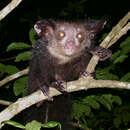en
names in breadcrumbs


Perception Channels: tactile ; chemical
Other Physical Features: endothermic ; bilateral symmetry
Key Reproductive Features: gonochoric/gonochoristic/dioecious (sexes separate); sexual
Daubentoniidae is a primate family containing a single extant species (the aye-aye, Daubentonia madagascariensis).Daubentoniidae is only family in the genus Daubentonia, which is the lone member of the infraorder Chiromyiformes.The aye-aye is a strepsirrhine primate native to Madagascar.
Phylogenetic history: In the past, it was contentious whether or not Daubentoniidae should be classified under the Lemuriformes infraorder alongside the other lemur families or whether it should be placed into its own Chiromyiformes infraorder. In 2005, Colin Groves upheld the Lemuriformes-Chiromyiformes separation (Wilson & Reeder, 2005). Other genetic and morphological studies have also maintained the separation of Chiromyiformes and Lemuriformes (Chatterjee et al., 2009; Goodman et al., 1998; Roos et al., 2004; Stanger-Hall, 1997). In 2008, Groves and other scholars seem to define lemurs as monophyletic, classifying Daubentoniidae as a member of the Lemuriformes infraorder (Mittermeier et al., 2008), though this author believes the wording is unclear and that an explicit rejection of the Chiromyiformes taxonomy is not present.